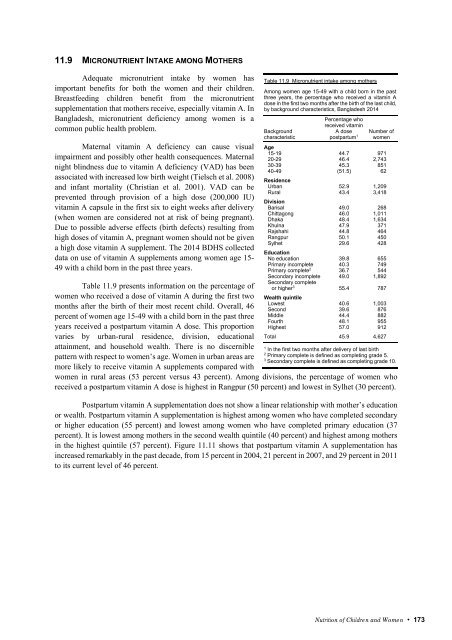Bangladesh 2014
8ln3LMTjp
8ln3LMTjp
Create successful ePaper yourself
Turn your PDF publications into a flip-book with our unique Google optimized e-Paper software.
11.9 MICRONUTRIENT INTAKE AMONG MOTHERS<br />
Adequate micronutrient intake by women has<br />
important benefits for both the women and their children.<br />
Breastfeeding children benefit from the micronutrient<br />
supplementation that mothers receive, especially vitamin A. In<br />
<strong>Bangladesh</strong>, micronutrient deficiency among women is a<br />
common public health problem.<br />
Maternal vitamin A deficiency can cause visual<br />
impairment and possibly other health consequences. Maternal<br />
night blindness due to vitamin A deficiency (VAD) has been<br />
associated with increased low birth weight (Tielsch et al. 2008)<br />
and infant mortality (Christian et al. 2001). VAD can be<br />
prevented through provision of a high dose (200,000 IU)<br />
vitamin A capsule in the first six to eight weeks after delivery<br />
(when women are considered not at risk of being pregnant).<br />
Due to possible adverse effects (birth defects) resulting from<br />
high doses of vitamin A, pregnant women should not be given<br />
a high dose vitamin A supplement. The <strong>2014</strong> BDHS collected<br />
data on use of vitamin A supplements among women age 15-<br />
49 with a child born in the past three years.<br />
Table 11.9 presents information on the percentage of<br />
women who received a dose of vitamin A during the first two<br />
months after the birth of their most recent child. Overall, 46<br />
percent of women age 15-49 with a child born in the past three<br />
years received a postpartum vitamin A dose. This proportion<br />
varies by urban-rural residence, division, educational<br />
attainment, and household wealth. There is no discernible<br />
pattern with respect to women’s age. Women in urban areas are<br />
more likely to receive vitamin A supplements compared with<br />
Table 11.9 Micronutrient intake among mothers<br />
Among women age 15-49 with a child born in the past<br />
three years, the percentage who received a vitamin A<br />
dose in the first two months after the birth of the last child,<br />
by background characteristics, <strong>Bangladesh</strong> <strong>2014</strong><br />
Background<br />
characteristic<br />
Percentage who<br />
received vitamin<br />
A dose<br />
postpartum 1<br />
Number of<br />
women<br />
Age<br />
15-19 44.7 971<br />
20-29 46.4 2,743<br />
30-39 45.3 851<br />
40-49 (51.5) 62<br />
Residence<br />
Urban 52.9 1,209<br />
Rural 43.4 3,418<br />
Division<br />
Barisal 49.0 268<br />
Chittagong 46.0 1,011<br />
Dhaka 48.4 1,634<br />
Khulna 47.9 371<br />
Rajshahi 44.8 464<br />
Rangpur 50.1 450<br />
Sylhet 29.6 428<br />
Education<br />
No education 39.8 655<br />
Primary incomplete 40.3 749<br />
Primary complete 2 36.7 544<br />
Secondary incomplete 49.0 1,892<br />
Secondary complete<br />
or higher 3 55.4 787<br />
Wealth quintile<br />
Lowest 40.6 1,003<br />
Second 39.6 876<br />
Middle 44.4 882<br />
Fourth 48.1 955<br />
Highest 57.0 912<br />
Total 45.9 4,627<br />
1<br />
In the first two months after delivery of last birth<br />
2<br />
Primary complete is defined as completing grade 5.<br />
3 Secondary complete is defined as completing grade 10.<br />
women in rural areas (53 percent versus 43 percent). Among divisions, the percentage of women who<br />
received a postpartum vitamin A dose is highest in Rangpur (50 percent) and lowest in Sylhet (30 percent).<br />
Postpartum vitamin A supplementation does not show a linear relationship with mother’s education<br />
or wealth. Postpartum vitamin A supplementation is highest among women who have completed secondary<br />
or higher education (55 percent) and lowest among women who have completed primary education (37<br />
percent). It is lowest among mothers in the second wealth quintile (40 percent) and highest among mothers<br />
in the highest quintile (57 percent). Figure 11.11 shows that postpartum vitamin A supplementation has<br />
increased remarkably in the past decade, from 15 percent in 2004, 21 percent in 2007, and 29 percent in 2011<br />
to its current level of 46 percent.<br />
Nutrition of Children and Women • 173


